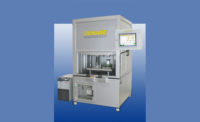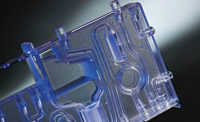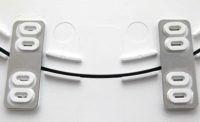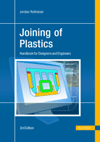With feedback from load cells, encoders and other sensors, today’s microprocessor-controlled plastic welders offer extraordinary command over every aspect of the joining process. Depending on the machine, engineers can monitor and control ram force, ram speed, amplitude, power, energy, weld distance, weld time and hold time. These parameters can be measured individually or in combination to produce a good weld every cycle, regardless of the size, shape or composition of the parts.
Here’s a look at the latest technology for welding plastic parts.
Ultrasonic Welder Assembles Medium, Large Parts
The Standard 3000 pneumatic ultrasonic welder is suitable for assembling medium to large plastic parts. The 20-kilohertz welder can apply a maximum force of 3,000 newtons and has a maximum stroke of 100 millimeters. Stroke length can be set in 0.01-millimeter increments for precise welding applications. The machine can store 32 parameter sets. The machine can be used for welding, cutting and punching thermoplastic parts, nonwovens, textiles and films. It can also be used for embedding metal inserts in plastic. The machine can be housed in a noise-protection enclosure or integrated into automated assembly lines. A variant, the Standard 3000 CR, is certified for use in ISO class 6 clean rooms. See this company at The Assembly Show South April 4-6 in Nashville.
Rinco Ultrasonic USA Inc.
Low-Frequency Vibration Welder
The LFVW 6970 with Melt-Match is a new line of servo-driven, low-frequency vibration welders for precision assembly of large thermoplastic parts. Servo drive technology enables the ram to approach the workpiece quickly, which reduces cycle time, while also providing optimal contact force, which improves consistency and quality.
The machine is designed as a single-piece construction, which includes a control cabinet, sound enclosure and robust frame. This reduces installation time and extends the life of the machine. There’s no need to disassemble and reassemble the machine to move it from one site to another.
Melt-Match technology provides closed-loop control of the welding process. It detects the transition from solid to molten state. It then accurately controls the melt flow of the plastic during the weld and later during the transition from molten material back to solid. Digital force sensing gives engineers better control of the trigger and welding force. This ensures a uniform melt and a hermetic seal, and it helps avoid weld joint deformation and cold welds. Force and weld velocity can be programmed in 10 independent segments to match the melt flow rate of the material.
The machine is “Industry 4.0 ready,” providing remote connectivity for faster diagnosis, data acquisition and service. The machine is equipped with easy-to-use HMI software for efficient process control, providing real-time graphing of amplitude, force and collapse distance. The HMI software stores 200 weld setups. On-tool controls ensure that parts are present and held in place.
The machine includes four continuously supported rails with eight reciprocating bearings to eliminate table chattering, improve table alignment, and eradicate unwanted machine resonance. The large mechanical mass of the linear vibration head, coupled with the solid welded tubular steel frame construction, eliminates machine failure due to the vibration process and provides one of the quietest machines in the industry.
Options include an automatic load and unload station, indexing conveyors, adjustable safety switches and quick tool changing cart.
See this company at The Assembly Show Oct. 24-26 in Rosemont, IL.
Dukane
Servo-Driven Ultrasonic Welder
The sonxTOP servo-driven ultrasonic welder features a deflection-free frame. This allows the welder to build forces during the weld cycle without compromising the parallelism between the sonotrode and parts, which ensures consistent contact during the weld cycle. Deflection has been an issue with some ultrasonic welding systems, which contributes to process instability and shimming of fixtures. The welder can apply force from 5 to 3000 newtons.
A unique capability of the machine is the ability conduct tensile testing. If pull-force testing is required as a quality specification for the job, the welder can be set up to have these pull forces measured right on the machine after a predetermined number of welds have been produced.
The machine’s touch-screen HMI includes 30 I/O, unlimited storage of data for all welded parts for one year, Industry 4.0 communications, and digital tracking of program changes.
Models are available with frequencies ranging from 20 to 35 kilohertz and with power levels from 1,000 to 6,000 watts. The machine is available in both benchtop and inline configurations.
See this company at The Assembly Show Oct. 24-26 in Rosemont, IL.
MS Ultrasonic Technology Group
Handheld Ultrasonic Welder
The HandyStar Energy is a handheld 35-kilohertz ultrasonic tool for spot welding, staking, riveting, crimping and cutting.
It provides 600 watts of peak power and 375 watts of continuous power. The energy mode controls the energy used per weld. As a result, high process stability is guaranteed despite manual activity. Time mode and manual mode are also available.
The device is based on the company’s proven Multi-Application Generator, which provides high reliability, long service life, and low maintenance. Converter cooling by compressed air is integrated in the unit and is switched on automatically if required. This minimizes the consumption of cooling air.
The controller stores 16 job setups, and the sonotrode can be swapped out for different applications. A weld counter gives the operator certainty that all welding points have been completed.
Telsonic Ultrasonics Inc.
Ultrasonic Welder Features ‘Dynamic Mode’
The Elite Precision+ version of the GSX-E1 ultrasonic plastic welder features a “dynamic mode,” which enables engineers to monitor, recalculate and adjust multiple weld parameters in real time and optimize weld performance within a user-specified target result, such as part compression, positioning or pull strength. Dynamic mode provides more consistent results by welding in accordance with the design profile of the part instead of a single parameter.
An advanced electromechanical weld actuator, new ultrasonic welding algorithms, high-speed data communications and increased computing power make this possible. Upgraded software supports more robust automation and faster actuator response when interfacing with PLCs and gives engineers more flexibility in developing and deleting application-specific welding recipes.
To use a welder equipped with dynamic mode, the engineer selects the single-parameter weld mode that provides the best application results. Then, the engineer enters two application-specific “scores,” which act as limits for dynamic mode activity. The first is a material density score that characterizes the hardness or resistance of the material to be welded. A low density score equates to a harder, more resistant material. The second is a weld reactivity score, which fine-tunes the reaction time the welder needs to achieve the desired density setting. In operation, dynamic mode monitors each weld cycle, using the density and reactivity limits to optimize the cycle in response to specific part-to-part variabilities throughout production.
Dynamic mode ultrasonic welding can outperform single-parameter weld modes when:
- assembling electronic components that are sensitive to pressure, vibration or heat damage.
- close-tolerance assemblies containing sensitive components require hermetic seals.
- part structures rely on consistent performance of flexible or elastomeric components.
- elements must be staked or inserted into substrates that vary in hardness or structural consistency.
For example, consider the need to weld a form-fitting, watertight plastic cover onto the shell of a small electronic device. The cover is closely contoured to fit around the electronic components. The cover must be bonded gap-free and watertight, but the weld process and cover structure cannot be allowed to contact or compress the electronics directly beneath. Due to ordinary part variability, reliance on a single-parameter weld mode, such as collapse distance, could exert excessive pressure on the cover and damage the electronics. With the help of material density and reactivity scores, the dynamic welding mode can optimize the collapse distance in each weld cycle to ensure a tight seal without compressing the electronic components.
Dynamic mode is also useful for bonding plastic assemblies that contain compressible materials. Consider, for example, an elastomer-filled, two-way pin connector. The outer shell of the connector consists of a molded plastic cup and lid that contain holes through which metal connecting pins protrude. Inside, the pins are embedded in a compressible core of elastomeric plastic, topped by a weld-on lid that compresses the elastomer radially around the pins. Despite the fact that the elastomeric cores vary in height, sealing of the plastic lid requires a flat fit.
In dynamic weld mode, the density score enables weld-by-weld adjustment that compensates for the varied consistency and height of each plug’s elastomer core. It ensures that the weld actuator travels the required depth and that it “feels” the specified amount of resistance before welding the lid.
Emerson
Enclosure Insulates Sound From Welding Process
Ultrasafe is an ergonomic workstation for manually operated ultrasonic welding systems. An enclosure with an adjustable lifting door provides protection from the high-pitched noise generated during welding while also enabling user-friendly loading of the machine. The entire front of the machine moves upwards, revealing a large working area. This gives workers greater flexibility for loading parts, cleaning fixtures and changing tools. To reduce cycle time, engineers can vary how far the enclosure travels. To accommodate workers of different stature, the height of the worktable can be adjusted with an electric actuator.
Herrmann Ultrasonics Inc.












